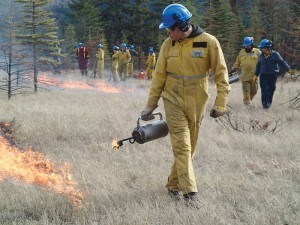
Upon completion of the Parks Canada Basic Wildland Fire Course, 11 youth from Grande Cache— many descendants of families who used to live on what is now park land— restored fire to a small area near the Ewan Moberly Homestead last month.
Aided by Parks Canada staff, the group burned approximately two hectares of grassland and forest just north of the Ewan Moberly buildings using drip torches. The burned area is now part of a downwind fireguard used for future burning in the Snaring Meadows Complex. The Basic Wildland Fire Management Course and the prescribed burning in the Snaring Meadows Complex provides an excellent opportunity for Parks Canada to connect youth to the land and the practices of their ancestors.
For the past 10,000 years, fire has been part of this landscape. Aboriginal fire use is considered an important part of local fire history. Families historically living in the Athabasca Valley burned lands in the spring to keep meadows open and productive for the grazing of horses and cattle, to grow hay and to improve desirability of the area for wildlife.
The establishment of Jasper National Park in 1907 led to the departure of these families, a loss of cultural burning, and subsequent loss of open grasslands.
Parks Canada maintains good working relationships with many Aboriginal and Metis groups, and values the opportunity to work together with them. Through initiatives such as the Basic Wildland Fire Management Course, Parks Canada has been able to engage with its partners to gain and share knowledge about fire dependant ecosystems, and build a community of stewards.
Snaring Meadows Complex prescribed fire
Using a blend of traditional burning techniques and some modern tools, Parks Canada is restoring the area near the Ewan Moberly Homestead, to what it was before the era of fire suppression.
This spring, the park’s fire team began conducting small-scale prescribed fires to provide downwind fireguards for subsequent burning in the 30-hectare Snaring Meadows Complex.
Located 21 km north of the Town of Jasper and on both sides of the Snaring Road, this complex consists of five small sub-units that will be burned sequentially—each providing the fireguard for the previous sub-unit. These prescribed fires will emulate the cultural burning that took place here in the early 1900s.
Preliminary work on the complex was done in consultation with traditional Aboriginal groups with ties to this area. In 2011 and 2012, the Jasper National Park fire team thinned and removed vegetation around the historic Moberly building to help protect it from fire.
Reintroducing fire in this area will help restore grassland vegetation in the valley bottom. This in turn will rejuvenate good quality wildlife habitat for ungulates and numerous bird species.
Additionally, these burns will reduce forest fuel continuity and the likelihood of fire spread in the Athabasca River valley.
Parks Canada
Special to the Fitzhugh
